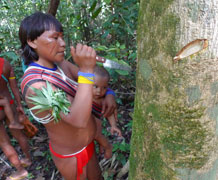
If properly managed, Amazonian parks, reserves, and indigenous territories may protect most of the threatened species. Image credit: William Milliken, RBG Kew.
Half of all Amazonian tree species may be globally threatened
More than half of all tree species in the world’s most diverse forest—the Amazon—may be globally threatened, according to a new study. The study also suggests that Amazonian parks, reserves, and indigenous territories, if properly managed, will protect most of the threatened species.
The findings were announced by a research team comprising 158 researchers from 21 countries, including co-author Dr Ted Feldpausch, a research in Geography at the University of Exeter, and led by Hans ter Steege of Naturalis Biodiversity Center in the Netherlands and Nigel Pitman of the Field Museum in Chicago, USA,
Forests in the Amazon have been declining since the 1950s, but scientists still have a poor understanding of how this has affected populations of individual species.
The new study, published this week in the journal Science Advances, compared data from forest surveys across the Amazon with maps of current and projected deforestation to estimate how many tree species have been lost, and where.
The authors concluded that the Amazon could harbour more than 15,000 tree species, of which 36 to 57 percent likely qualify as being globally threatened under IUCN Red List of Threatened Species criteria.
“We aren’t saying that the situation in the Amazon has suddenly gotten worse for tree species,” said Pitman. “We’re just offering a new estimate of how tree species have been affected by historical deforestation, and how they’ll be affected by forest loss in the future.”
The research team had previously reported in Science that the Amazon may harbour more than 15,000 tree species. The new study estimates that up to 8,690 of those species may face extinction. Because the same trends observed in Amazonia apply throughout the tropics, the researchers argue that most of the world's >40,000 tropical tree species likely face the same risk.
Fortunately, the authors say, protected areas and indigenous territories now cover over half of the basin, and likely contain sizable populations of most threatened species.
“This is good news from the Amazon that you don’t hear enough of,” said ter Steege. “In recent decades Amazon countries have made major strides in expanding parks and strengthening indigenous land rights,” he said. “And our study shows this has big benefits for biodiversity.”
However, parks and reserves will only prevent extinction of threatened species, the paper emphasizes, if they suffer no further degradation said Carlos Peres from the School of Environmental Sciences in Norwich, UK. The authors caution that Amazonian forests and reserves still face a barrage of threats, from dam construction and mining to wildfires and droughts intensified by global warming, and direct invasions to indigenous lands.
“The vast majority of protected areas in the Amazon have no management plan or budget and few resident qualified personnel", said Rafael Salomão from Emílio Goeldi Museum, Belem, Brazil".
“It’s a battle we’re going to see play out in our lifetimes,” said William Laurance from James Cook University in Australia.
“Either we stand up and protect these critical parks and indigenous reserves, or deforestation will erode them until we see large-scale extinctions” said Laurance.
Date: 20 November 2015
